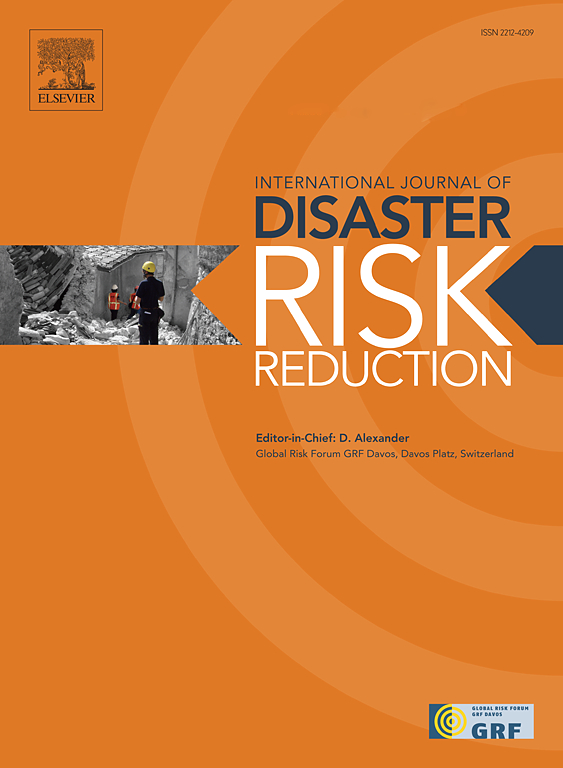Spatiotemporal evolution and influencing factors of flood resilience in Beibu Gulf Urban Agglomeration
IF 4.2
1区 地球科学
Q1 GEOSCIENCES, MULTIDISCIPLINARY
International journal of disaster risk reduction
Pub Date : 2024-11-01
DOI:10.1016/j.ijdrr.2024.104905
引用次数: 0
Abstract
In the context of global climate change and rapid urbanization, enhancing flood resilience is essential for mitigating urban flood risk. However, few studies have conducted long-term, cross-scale dynamic evaluations of flood resilience and analyzed its influencing factors and mechanisms. Taking the Beibu Gulf urban agglomeration as the study area, a long-term, cross-scale dynamic evaluation index system based on the “Robustness-Resistance-Recovery” (3Rs) framework was developed to assess the spatiotemporal evolution of flood resilience from 2000 to 2020. Furthermore, the optimal parameters-based geographical detector model is employed to identify the key influencing factors and mechanisms. The results reveal that pre-flood robustness is lower in coastal areas and higher in inland areas. In the during-flood stage, cities with greater comprehensive power exhibit stronger resistance. Post-flood recovery is higher in city centers and marginal mountainous areas, while coastal and inland low-lying areas show lower recovery. The flood resilience of urban agglomerations has improved in recent years, largely due to the enhancement of urban flood control infrastructure and healthcare capacity. However, disparities between cities persist. From 2000 to 2020, economic factors have been the primary drivers of improved flood resilience, while ecological factors have gained increasing importance over the past decade. These findings provide valuable insights for flood prevention, mitigation, and resilience management in urban agglomerations. The developed dynamic evaluation index system offers a reference framework for evaluating flood resilience in other regions.
北部湾城市群抗洪能力的时空演变及影响因素
在全球气候变化和快速城市化的背景下,提高抗洪能力对于降低城市洪水风险至关重要。然而,很少有研究对抗洪能力进行长期、跨尺度的动态评价,并分析其影响因素和机制。本研究以北部湾城市群为研究区域,基于 "稳健性-抵抗力-恢复力"(3Rs)框架,建立了一个长期、跨尺度的动态评价指标体系,以评估 2000 年至 2020 年洪涝灾害恢复力的时空演变。此外,还采用了基于最优参数的地理探测器模型来确定关键影响因素和机制。结果表明,洪水前沿海地区的抗洪能力较低,内陆地区较高。在洪灾期间,综合实力较强的城市表现出较强的抗灾能力。洪灾后,城市中心区和边缘山区的恢复能力较强,而沿海和内陆低洼地区的恢复能力较弱。近年来,城市群的抗洪能力有所提高,这主要归功于城市防洪基础设施和医疗保健能力的增强。然而,城市之间的差距依然存在。从 2000 年到 2020 年,经济因素一直是提高抗洪能力的主要驱动力,而生态因素在过去十年中则变得越来越重要。这些发现为城市群的防洪、减灾和抗洪管理提供了宝贵的启示。所开发的动态评估指标体系为评估其他地区的抗洪能力提供了参考框架。
本文章由计算机程序翻译,如有差异,请以英文原文为准。
求助全文
约1分钟内获得全文
求助全文
来源期刊

International journal of disaster risk reduction
GEOSCIENCES, MULTIDISCIPLINARYMETEOROLOGY-METEOROLOGY & ATMOSPHERIC SCIENCES
CiteScore
8.70
自引率
18.00%
发文量
688
审稿时长
79 days
期刊介绍:
The International Journal of Disaster Risk Reduction (IJDRR) is the journal for researchers, policymakers and practitioners across diverse disciplines: earth sciences and their implications; environmental sciences; engineering; urban studies; geography; and the social sciences. IJDRR publishes fundamental and applied research, critical reviews, policy papers and case studies with a particular focus on multi-disciplinary research that aims to reduce the impact of natural, technological, social and intentional disasters. IJDRR stimulates exchange of ideas and knowledge transfer on disaster research, mitigation, adaptation, prevention and risk reduction at all geographical scales: local, national and international.
Key topics:-
-multifaceted disaster and cascading disasters
-the development of disaster risk reduction strategies and techniques
-discussion and development of effective warning and educational systems for risk management at all levels
-disasters associated with climate change
-vulnerability analysis and vulnerability trends
-emerging risks
-resilience against disasters.
The journal particularly encourages papers that approach risk from a multi-disciplinary perspective.
 求助内容:
求助内容: 应助结果提醒方式:
应助结果提醒方式:


